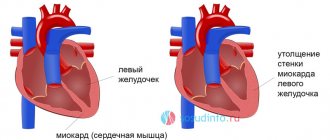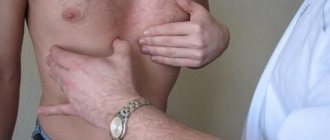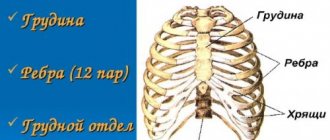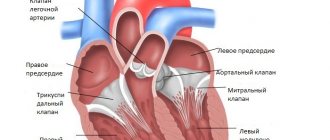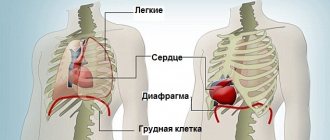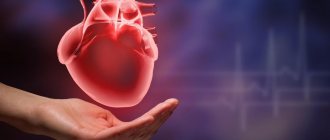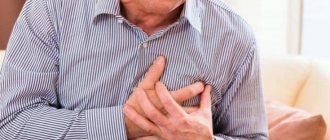The rib under the heart hurts - what to do?
Modern people are negligent about their health.
Many suffer symptoms such as spasms, compression in the chest and abdomen on their legs, without seeking help from a medical facility. It is important to understand that if a rib under the heart hurts or there is discomfort associated with breathing, you need to immediately diagnose your health and rule out dangerous diseases of the main “motor” of the body and blood vessels. One of the most common complaints from patients in the hospital is a description of the sensation when the heart hurts, but for some reason it radiates to the rib.
Typically, the doctor redirects such patients to a cardiologist or arrhythmologist. Such signs of a pathological condition indicate a high probability of a heart attack or stroke. But other reasons cannot be ruled out. Almost any system in our body can provoke spasms and discomfort under the sternum.
What can hurt and is located right under the heart?
Most people are very interested in what is under the heart - when experiencing pain on the left side of the body, we first try to understand its origin. The heart is one of the most important organs in the human body. Its function is to continuously pump blood to all parts of the body to supply cells with nutrients and oxygen, as well as remove waste products from the venous blood.
One of the causes of pain on the left side in the hypochondrium may be cardiac dysfunction and heart diseases such as myocardial infarction, coronary heart disease, and cardiomyopathy. Along with aching or acute pain, these ailments may cause heaviness in the chest, nausea, increased heart rate, dizziness, and shortness of breath. If these signs appear, you should immediately consult a doctor for diagnosis and medical care.
How to properly respond to painful symptoms
The only correct solution when discomfort appears on the left side of the body is to go to the hospital.
Only an experienced specialist can promptly identify the source of spasms and prescribe correct, adequate treatment.
The doctor will ask the patient about the nature of the sensations.
First of all, the doctor finds out the location of the painful symptoms (pain below the heart under the ribs or discomfort spreads over a large area). It is important to correctly describe where the spasm “gives” to. If the scapula or collarbone are caught, then an additional cardiogram or other type of hardware diagnostics should be performed. It would be a good idea to tell your doctor about the methods of therapy that were used previously. Often, if the rib on the left under the heart hurts, then applying a heating pad, taking analgesics or simply resting in a supine position will help. Such changes usually indicate problems in the digestive system or musculoskeletal system.
Common sources of pathological condition
You need to understand that if there is pain in the area of the ribs under the heart, then this is not necessarily the first sign of a heart attack. The cause of discomfort often lies in dysfunction of other body systems.
TOP 5 diseases that cause discomfort in the left hypochondrium:
- Appendicitis. Let's start with the most dangerous condition, requiring immediate hospitalization. If there is severe pain below the heart, on the left under the ribs, and it does not get better over time, then you should immediately call an ambulance at home. Most often, the big one complains of cutting, sharp pain, which increases with changes in body position.
- Inflammation of the pancreas. The easiest way to determine the cause of their suffering is for people suffering from pancreatitis. Doctors note that with this disease the sensations are mild, aching, strong, and increase with inhalation. Discomfort is usually caused by drinking alcohol or overeating.
- Intercostal neuralgia. If the ribs on the left side under the heart hurt and muscle twitching, numbness in the hands, increased sweating and blood flow from the skin appear, then most likely an untreated cold, draft or hypothermia provoked a disease of the nerve endings.
- Osteochondrosis of the thoracic region. This disease affects people who lead a sedentary lifestyle. A prolonged immobile position of the body leads to compression of the nerve endings and, as a result, painful sensations on the left or right side of the body. Many experts note the spread of symptoms to the buttock and tailbone.
- Myocardial infarction . For people at risk for vascular disease, it is important to always have the right medications on hand. In the case when the left side hurts under the ribs, radiates to the heart and such a symptom is accompanied by shortness of breath, nausea, vomiting, numbness of the upper extremities, cyanosis of the face, therapy must be started immediately.
In addition to the above pathologies, severe discomfort on the left side of the body can be caused by dry pleurisy, herpes zoster, gastritis, ulcers, inflammation of the spleen and even lung cancer. There are a lot of options, so you should not hesitate to seek help from specialized specialists (cardiologist, endocrinologist, gastroenterologist, surgeon). Remember that correct diagnosis and timely initiation of treatment can save your life!
Pain under the rib on the left side. What disease does this symptom warn about?
Pain under the rib on the left side can signal a very dangerous disease. And these may not only be heart ailments, as many may think. Pain in this area can be felt in the spleen, diaphragm, heart, stomach, and even the nervous system. Therefore, it is necessary to listen to your body and determine the nature of the pain. If the discomfort in the left hypochondrium is long-lasting and intense, call a doctor immediately.
Stomach
If the pain under the rib on the left side is also accompanied by vomiting and nausea, then the cause is most likely related to a gastrointestinal disease.
- Flatulence and constipation. These diseases can radiate pain to the left side. Food poisoning (may also manifest itself through high fever and vomiting). Gastritis. Symptoms: pain - intense or aching, which is also accompanied by vomiting, dizziness, bloating and weakness. Stomach ulcer. With this disease, pain usually appears after eating.
Spleen
Pain on the left side under the ribs may indicate an enlarged spleen or even a rupture. Severe pain can occur with the following diseases:
- Spleen injury (open or closed). Usually accompanied by severe pain in the hypochondrium, tachycardia, hypotension, nausea and thirst. Splenic infarction occurs due to blockage of an artery. In this case, the pain when inhaling becomes stronger. A splenic abscess is an accumulation of large amounts of pus. In such cases, the pain may radiate to the left shoulder.
Pancreas
This organ partly extends into the area of the left hypochondrium. Therefore, if there is pain on the left side under the breast, this can also be a symptom of pancreatic ailments.
- Chronic pancreatitis is characterized by dull pain. Acute pancreatitis is accompanied by cutting and sharp pain in the left side.
The diaphragm is the muscle that separates the abdominal cavity from the chest cavity. Pain on the left side under the ribs can signal a serious illness such as a diaphragmatic hernia. This disease occurs due to the displacement of abdominal organs into the chest. In such cases, the discomfort becomes more intense during heavy physical activity and during meals.
If there is severe pain on the left side under the chest, accompanied by shortness of breath and a feeling of lack of air, then this indicates problems with the heart. In most cases, we are talking about coronary heart disease at various stages.
- Myocardial infarction is characterized by severe, tearing, squeezing pain in the region of the heart. Angina pectoris. With this disease, the pain is short-lived.
Other causes of pain in the left hypochondrium
- Intercostal neuralgia is formed when the intercostal nerves are compressed. Accompanied by severe pain of various types: aching, dull, sharp, paroxysmal, burning. Abdominal migraine is a disorder of the nervous system. One of the symptoms of this disease is pain under the rib on the left side or in the middle of the abdomen. Hormonal imbalance can also be the cause of such painful sensations. This symptom mainly manifests itself during menopause in women, puberty in adolescents and in diseases of the endocrine system.
We have provided a far from complete list of diseases, the symptom of which is pain under the rib on the left side. As you can see, diseases can be either minor (flatulence) or very serious (myocardial infarction). Therefore, in such cases, do not endure the pain, but immediately call emergency help.
Intercostal neuralgia
Intercostal neuralgia, also known as “thoracic radiculitis,” is a common disease that occurs in people aged 40-45 years (in some cases in young people over 25 years old). The cause is often: osteochondrosis, diabetes mellitus, aneurysm, body features, mechanical injuries, hypothermia, inflammation in the sternum and spine.
An additional reason for the development of thoracic radiculitis can be gastrointestinal diseases, pleurisy, excess weight, inactive lifestyle, stress and physical fatigue.
- Pain under the heart on the left side
- Sharp pain when inhaling/exhaling
- Movements of body parts constrained by acute pain
- Redness of the skin and swelling in the sternum and back
- Pain radiates to other parts of the body (arm, lower back, shoulder, fingers)
- “Shooting pain” between the ribs
Neuralgia needs to be treated comprehensively, using medications, physiotherapeutic procedures and traditional methods.
In drug treatment, drugs are used to relieve pain and relieve inflammation. As a rule, these are analgesics, antispasmodics, antibiotics and antihistamines.
Physiotherapeutic procedures involve the treatment of intercostal neuralgia with manual therapy, including massage, hydromassage, UHF, compresses, heating, ultraphonophoresis, etc. As for traditional methods, there are so many of them that it is impossible to list them in one review. They use heating pads, compresses, tinctures, natural-based ointments and much more.
Before using any drug in the treatment of intercostal neuralgia, you must always consult with your doctor. Do not self-medicate.
Pancreas (pancreatitis)
A dangerous disease that appears with pain under the heart, behind the sternum, on the side and in the middle of the abdomen. Weakness, pale skin, diarrhea, vomiting, and flatulence also appear. As a rule, inflammation of the pancreas provokes the development of diabetes.
The cause of pancreatitis is fatty foods in large quantities and alcoholism. In rare cases, the cause in children is cystic fibrosis, a serious hereditary disease.
Pancreatitis is diagnosed based on patient complaints, based on ultrasound and CT data. In certain cases, colonoscopy is indicated.
Treatment involves complete abstinence from junk food and alcoholic beverages. In addition, the doctor prescribes a well-known enzyme drug - panctreatin. For chronic pancreatitis, “strong” analgesics are prescribed, because the pain becomes very severe.
Problems with the pancreas
The most common disease of the pancreas is pancreatitis, an inflammation caused by alcohol consumption and poor diet. Smoked, very fatty or spicy foods with large amounts of protein, preservatives and flavorings have a negative effect on this delicate organ. The pancreas also suffers from butter creams, bone broths, jellied meat, aspic, mustard, horseradish, radishes, fast food and, of course, alcohol.
A number of antipyretics, diuretics, non-steroidal anti-inflammatory drugs, sulfonamide drugs and hormonal contraceptives can cause an attack of pancreatitis.
Symptoms of problems with the pancreas are pain that increases in the left hypochondrium after eating and radiates to the right hypochondrium or back, as well as nausea, sour vomiting, diarrhea and pain on palpation of the umbilical area. To avoid such conditions, you need to eat stewed vegetables, eat day-old yeast-free bread and drink enough alkaline mineral water, specifically designed to treat the pancreas.
Gastrointestinal diseases
Diseases of the gastrointestinal tract can cause pain under the heart. Among the most common we note:
- Gastritis, duodenitis
- Duodenal ulcer
- Hiatal Hernia
- Colitis
- Dysbacteriosis
The above diseases can cause associated symptoms such as bloating, diarrhea, constipation, pain in the sternum, abdomen, side and back, cramps, nausea.
Treatment of gastrointestinal diseases is carried out under the supervision of a gastroenterologist and therapist. Strict diets are prescribed, excluding salty, fried, spicy, and fatty foods. Medications are aimed at coating the walls of the intestines and stomach, thereby reducing acidity.
For inflammatory processes, antibiotics, antispasmodics, and painkillers are prescribed. Take all medications only under the supervision of a doctor, no self-medication.
Pathologies of the respiratory system
Pain in the left side of the chest near the heart can act as one of the manifestations of the clinical picture in the following pathologies of the bronchopulmonary system:
- pneumonia (pneumonia);
- pneumothorax;
- pulmonary embolism.
The most dangerous conditions for the patient include embolism - thrombosis of an artery passing through the lungs. Disruption of the oxygen supply to the lungs can lead to dire consequences, including the death of the patient.
The following symptoms indicate this pathology:
- disturbance, difficulty in respiratory function;
- rapid, labored breathing;
- increasing pain in the sternum when inhaling.
In the case of an inflammatory process localized in the lung area, patients experience a fever, cough syndrome, mucous discharge, and general weakness.
Pain on the left side in the heart area
Upon reaching the age of 30-35 years, a person is often bothered by unpleasant pain in the area of the heart, which appears seemingly for no reason. Pain can occur with deep breaths, active movements, be constant or periodic, sharp and dull, radiate to the arm, cause difficulty breathing. It is important to understand what caused the pain syndrome and take the necessary measures, more on this in the article below.
Since childhood, we are taught to be very attentive to any manifestations of discomfort that arise in this area, so the symptom that appears is very frightening. In fact, there are quite a few causes of pain in this area.
In addition to the heart muscle, which is the first thing you think about, there are manifestations of spinal curvature, intercostal neuralgia, as well as the stomach, spleen and other abdominal organs. If we are talking specifically about the heart, then most likely there is coronary disease, hypertension and others.
Where is the heart actually located?
The heart muscle is considered a vital organ, with a volume approximately equal to a human fist. Its placement in the chest is slightly different from traditional ideas. The right edge is located approximately along the axis of the spine, the left border in men (in women, due to the difference in the shape and size of the breast, this landmark cannot be used) to the right of the left nipple, in height it begins approximately below the level of the collarbone in the area of the spine, in shape, expanding downward, and ends approximately between the 5th-6th rib.
Thus, one must understand that the placement of the heart is not radically left-sided, but simply to the left of the spinal axis.
How to understand whether your heart hurts or not?
After the appearance of pain in the chest, the first thing you should do is figure out and understand what its cause is, whether it is cardiological or non-cardiological.
When the heart or its vessels are susceptible to disease, pain on the left side is called cardiac and the following symptoms are distinguished:
- Location: behind the sternum, to the left border of the clavicle
- The type of pain is very different: aching, pressing, stabbing, dull
- No pain between the ribs or in the spine area
- Pain of cardiac origin is not associated with light physical activity, such as raising and lowering the arms, but occurs after physical activity
- Angina occurs as a result of eating a large amount of food and, for example, active walking after that. It is important to note that there will be no heartburn, belching or bowel irregularities.
- It often radiates to the left hand, the lower jaw on the left, is localized in the left shoulder blade, but there are no sensory disturbances, the left hand does not feel cold, there is no weakness, the skin color is normal.
What's below the heart on the left?
Perhaps most people, at least once in their lives, have experienced pain or other unpleasant sensations behind the sternum or to the left of it in the chest, exactly where the heart is located. These pains attract attention and cause concern more than many others - this is how we instinctively react to “problems” in the location of such an important organ.
It is not for nothing that pain in the heart area is the most common reason for seeking medical help. Characteristic pain in the left side of the chest occurs with myocarditis and pericarditis.
Most often, pain in the heart area occurs with the so-called stage 3 hypertension, when increased blood pressure and impaired blood flow lead to severe disorders of the heart and other organs.
Pain in the heart area, that is, in the left or central side of the sternum, can be for a variety of reasons. Conventionally, all chest pain can be divided into cardiological and non-cardiological.
Pain in this area varies. They prick, press, squeeze, bake, burn, whine, pull, pierce. They can be felt in a small area or spread throughout the chest, radiating to the shoulder, arm, neck, lower jaw, stomach, under the shoulder blade.
They can appear for a few minutes or last for hours, or even days on end, and can change with breathing, moving the arms and shoulder girdle, or changing posture.
There are many causes of pain in the heart area. They can be heart diseases such as angina pectoris, myocardial infarction, inflammation of the heart and its membranes, and rheumatic lesions. But often the source of pain is outside the heart, as, for example, with neurosis, diseases of the ribs and thoracic spine, problems with the gastrointestinal tract and many other diseases.
Non-cardiological nature of the pain that occurs
Non-cardiac means that the pain is not caused by the heart. If the intensity of pain on the left side varies with bending, turning the body, deep breathing, swinging and rotating the arms, and nitroglycerin does not have a neutralizing effect, then most likely the source will be intercostal neuralgia or radiculitis of the chest.
Neurosis is possible, the nature of the pain in it is aching or stabbing, it is concentrated locally and manifests itself briefly or periodically.
It has been proven that even ordinary stress and depression can cause physical pain in the left chest, so the classic scene when a woman clutches her heart after hearing something that shocked her is not a work of fiction.
The stabbing and squeezing nature of the pain is often caused by problems with the intestines, bloating, which disrupts the normal functioning of the heart muscle. If, when eating a certain type of food, you experience pain in the left breast, then perhaps the problem is the malfunction of the pancreas or the stomach itself. In addition to those indicated, a likely source may be a weak thoracic region, spinal curvature or osteochondrosis.
With neuralgia of the intercostal nerves (intercostal neuralgia), pain, which can be both chronic and acute, appears due to compression of the intercostal nerves. This type of pain is usually accompanied by burning, tingling or numbness in the rib area, including the left side. A characteristic feature is the lack of improvement effect if you take nitroglycerin. Intercostal neuralgia often appears with age; it can be caused by diseases of the spinal column, diabetes mellitus, and pathologies of the stomach and intestines.
Diagnostics
Pain under the heart on the left can be a symptom of various diseases, therefore, in each individual case, a specialist prescribes examinations to confirm or refute those ailments that, according to his assumptions, are the cause of pain.
abnormalities in the functioning of the heart muscle are suspected, the following diagnostic methods are used:
- blood tests (general, biochemical, genetic, etc.);
- electrocardiography;
- echocardiography;
- radiography;
- coronary angiography.
If the presence of splenic pathologies , the following diagnostic measures are used:
- blood test (general and biochemical);
- visual inspection for an increase in organ size;
- palpation;
- radiography;
- splenic puncture.
The latter diagnostic method is used only in cases of extreme necessity, since it is highly unsafe.
If there is a suspicion of the development of pathologies of the gastrointestinal tract, the doctor prescribes the following diagnostics:
- general blood analysis;
- fibrogastroduodenoscopy (to examine the condition of the esophagus, stomach and duodenum);
- analysis for Helicobacter Pylori and the presence of antibodies to this bacterium;
- analysis for the level of pepsinogens and gastrin;
- magnetic resonance imaging of the digestive organs;
- analysis for the presence of antibodies to gastric parietal cells.
Often, only the first 4 above points are used for diagnosis, since it is these methods that make it possible to confirm gastrointestinal diseases.
If pancreatitis , specialists prescribe:
- general blood and urine analysis;
- urine test for diastase;
- blood chemistry;
- scatological examination of stool;
- ultrasound diagnostics of the peritoneum;
- magnetic resonance imaging of the digestive organs;
- endoscopic retrograde cholangiopancreatography (examination of the pancreatic and bile ducts);
- endoscopic ultrasonography.
If specialists suspect the presence of an infection , then blood tests (including biochemical tests) and urine tests, ultrasound diagnostics of the spleen and liver are prescribed.
respiratory diseases are suspected, the following diagnostic methods are used:
- fluorography or digital x-ray;
- spiral computed tomography;
- pulmonary angiography using contrast;
- radionuclide research;
- sputum examination;
- blood tests (general, biochemical).
vegetative-vascular dystonia is suspected, the first step is to evaluate the autonomic nervous system at rest, electroencephalography of the brain, and an electrocardiogram. Additionally, the autonomic reactions of the nervous system are checked using orthostatic and pharmacological functional tests.
To study the presence of pathologies in the mammary glands, the following methods are used:
- palpation;
- radiography;
- mammography;
- fluorography;
- computed tomography;
- ultrasound examination of the mammary glands;
- histological examination;
- radiothermometry.
pathological processes in the spine are suspected, the following diagnostic measures are prescribed:
- neurological examination;
- computed tomography;
- magnetic resonance imaging;
- Doppler ultrasound.
cancer is suspected, the following examination methods are prescribed:
- plain radiography;
- ultrasonography;
- magnetic resonance imaging;
- computed tomography.
Additionally, blood tests (general and biochemical) and urine tests are prescribed. The patient is also referred for a biopsy and concentration of tumor markers.
Finding the Causes of Pain
After pain appears on the left side of the chest, the first thing you should do is consult a cardiologist to find out whether the pain syndrome is cardiological in nature.
The most accessible method for quickly diagnosing the functioning of the heart muscle and identifying pathologies in it is an ECG or electrocardiogram. The essence of the study is to attach sensors to the body, which, capturing the rhythm of the blood beat, produce a graph.
Using this chart, the cardiologist determines the presence of abnormalities in certain parts of the heart. A traditional ECG consists of obtaining a cardiogram in a quiet mode for just a few seconds. Often such a study is not enough to identify pathologies, then an ECG is performed “under load”, or Holter monitoring, when sensors and a receiver, powered by a battery, are attached to the patient’s body and readings are taken throughout the day. Due to this, the doctor sees a complete picture of the behavior of the heart muscle during all periods of wakefulness and sleep. Phonocardia is used to check for the presence of a heart murmur.
The general condition of the organ, as well as the functioning of the valves and the flow of blood in various parts of the heart, is checked using a procedure called echocardiography.
To assess the condition of the coronary arteries, a coronography procedure is performed, and deficiencies in the blood supply are checked using myocardial scintigraphy.
To verify the “non-cardiac” origin of pain on the left side, chest examinations are used using X-rays, computed tomography and MRI of the spinal region; for this you need to contact a neurologist or orthopedist; for more in-depth examinations, you need to visit a gastroenterologist.
When examining a patient, a cardiologist pays attention to how the patient talks about the symptoms.
The following relationship is used for assessment: if the patient speaks very vividly, in detail and openly about his painful sensations, without skimping on details, then, most likely, this indicates that the heart is not the source of pain.
An additional factor in favor of this conclusion is the detail that the pain is accompanied by a rapid heartbeat. And vice versa, a meager and dry narrative about the presence of pain with precise details, rather talk about “heart” reasons.
What to do if you have chest pain on the left?
Chest pain on the left first of all leads to the idea of heart problems, which may be the real reason. Therefore, when such a pain syndrome appears, you need to stop any physical activity, take a lying position, reducing the load on the heart and muscles, and provide an influx of fresh air into the room.
Regardless of the type of pain, if you are not completely sure of its “non-cardiac” origin, you need to put 1-2 tablets of nitroglycerin under the tongue. If your condition improves, contact your physician for an initial examination. A headache may occur after taking nitroglycerin; this is common as it lowers blood pressure.
If there is no effect from taking nitroglycerin, but difficulty breathing, weakness, pallor, and semi-fainting remain, then you should immediately call an ambulance, mentioning the pain in the left side of the chest and that nitroglycerin did not relieve the symptoms.
If the heart pain goes away immediately after being brought to a state of rest, then it is still important to contact a general practitioner, asking to schedule an ECG and an examination by a neurologist.
Angina pectoris
A more dangerous reason why a person complains of pain in the area of the ribs on the left side is improper functioning of the heart muscle. Such pain is caused, in particular, by ischemic disease, or, in other words, angina pectoris.
© shutterstock
Most often, men over 40 years of age suffer from this disease. The disease is hereditary, so the risk of its occurrence is higher in those men whose father or grandfather suffered from ischemia. In addition, other factors can also lead to the disease :
- Overweight.
- Sedentary lifestyle.
- Bad habits: tobacco and alcohol consumption.
- Poor nutrition.
- Stress.
Features of symptoms
With angina pectoris, there is pain behind the ribs on the left, the heart begins to beat at a rapid pace, and the patient experiences severe stress, more often even panic. It hurts on the left, when inhaling, the pain in the ribs intensifies, it is quite strong and can also radiate to the neck on the left, to the arm, to the back. Angina pectoris often frightens patients. The thing is that it is easily confused with manifestations of a heart attack - a dangerous pathology that often leads to death.
However, unlike a heart attack, an angina attack does not last longer than 10 minutes and goes away on its own. In addition, there is one more difference - with angina pectoris, the symptoms can be relieved with the help of an anesthetic - nitroglycerin is more often used, which is placed under the patient's tongue. In the event of a heart attack, pain on the left can only be weakened, but not completely removed.
Treatment methods
If an angina attack occurs while the patient is lying down, you need to help him sit up. If he was sitting, on the contrary, help him lie down. To relieve pain, you should give medicine, as well as a sedative in case of panic . The attack will pass after some time if the patient is at rest. However, if the pain on the left side does not stop after taking a painkiller, and the heart rate does not normalize after 10-15 minutes, you need to call an ambulance to rule out a heart attack.
Coronary artery disease is systemic and must be treated comprehensively. Attacks of pain on the left will be repeated regularly until the problem that led to the strain on the heart is eliminated. In particular, you will need to see a doctor and undergo regular tests, exercise and give up bad habits. A proper diet is also important, and your doctor will also help you create it.
Prevention of pain in the left side of the chest
As you learned from the article, the cause of pain on the left side of the chest is not always the heart muscle; in most cases we are talking about neuralgia, osteochondrosis, diseases of the stomach and intestines. For prevention in this case, it is necessary to reduce the effect of factors leading to complications. You should not overload yourself with excessive loads, eat a balanced healthy diet rich in vitamins, pay attention to sports, but without heavy loads. Exactly the same recommendations apply to prolong the proper functioning of the heart.
Author: site editor, date March 20, 2017
Nature and intensity of pain
The nature of the pain will help you determine which organ should be treated and which doctor to see.
1. A dull aching pain under the ribs on the left indicates:
- gastritis or gastric ulcer. May be accompanied by vomiting, which brings relief, decreased appetite and diarrhea;
- stomach cancer. May be accompanied by a sharp weight loss, weakness, anemia, symptoms similar to toxicosis in pregnant women (for example, the appearance of an aversion to meat);
- enlarged spleen;
- diseases of the pancreas. May be accompanied by fever, nausea or vomiting.
2. Sharp pain in the left hypochondrium may be a sign of:
- stomach or duodenal ulcers. May be accompanied by heartburn, vomiting and constipation;
- nervous overstrain.
3. Stitching pain on the left under the ribs indicates :
- lung diseases. Especially if it worsens with coughing and deep breaths (pneumonia, inflammation, tuberculosis or cancer of the left lung). May be accompanied by fever, shortness of breath, constipation and general intoxication of the body;
- ulcer of the duodenum or stomach. May be accompanied by nausea and vomiting;
- heart diseases;
- vegetative-vascular dystonia.
Possible causes and associated symptoms
Pain under the heart on the left side may not always indicate pathological abnormalities in the functioning of the myocardium. In some cases, this symptom is characteristic of diseases of other internal organs, and also occurs with injuries to the spine and ribs. Let's consider the main causes of pain under the heart on the left, as well as the distinctive symptoms in each case.
Heart diseases
If pain on the left side under the heart is felt from the front, this may indicate a heart attack. Acute and sharp pain in this area is also characteristic of an atypical form of ischemic myocardial disease.
Another cause of this condition is angina. The appearance of pain on the left side often occurs during physical exertion or emotional stress. This disease is characterized by attacks of pain in the form of a burning sensation, which can spread to the area of the left arm and shoulder blade for anywhere from several minutes to half an hour.
Also, such sensations are characteristic of the usual form of coronary heart disease.
Spleen
If there are disturbances in the functioning of the spleen, dull and aching pain under the heart on the left is felt in the area of the lower ribs. Often, pathological processes in this organ lead to its enlargement, and pain in this case may indicate conditions such as:
- benign lymphoblastosis;
- purulent abscess;
- lymphoma;
- leukemia;
- lymphocytic leukemia;
- tuberculosis;
- malaria;
- lupus.
With mechanical damage to this organ, pain on the left side under the heart may indicate a ruptured spleen. In this case, the pain is intense and acute.
Organs of the gastrointestinal tract
Disturbances in the functioning of these organs can also provoke pain on the left side under the heart. Often, such sensations are characteristic of the following diseases:
- gastritis;
- peptic ulcer;
- oncology.
With gastritis, the pain is dull and aching and occurs in attacks. Additionally, in addition to pain, the following symptoms are present:
- belching with a sour or putrid taste;
- gagging;
- loose stool.
In the case of low acidity with gastritis, pain usually occurs after eating food, and in case of increased acidity, pain usually occurs on an empty stomach.
The presence of an ulcer has a similar type of pain to the above ailment, however, in this case, such sensations occur regardless of the time of eating and are more pronounced in severity and intensity.
Pancreas
Inflammation of the pancreas is characterized by girdling pain, but in some cases the pain may occur on the left side under the heart. This condition usually occurs when eating the wrong foods or drinking too much alcohol.
Additionally, the disease is accompanied by the following symptoms:
- gagging;
- diarrhea;
- increased body temperature;
- yellowish skin tone.
Vomiting does not alleviate the condition, and the masses contain bile impurities. In some cases, lightening of the stool and darkening of the urine occurs.
Respiratory system
In this case, stabbing pain occurs during breathing. Worse when sneezing and coughing.
Pain under the heart on the left is caused by the following ailments:
- pneumonia;
- tuberculosis;
- malignant tumors in the lungs.
Typically, such disorders, in addition to pain, have additional symptoms:
- cough;
- shortness of breath;
- general malaise;
- cyanosis of the nasolabial triangle;
- heat;
- chills.
With pulmonary oncology, sudden weight loss, coughing with sputum and blood, and enlarged veins in the neck also often occur.
Psychosomatic reasons
In some cases, pain under the heart on the left may indicate the presence of vegetative-vascular dystonia. In this case, pain can be of different types. Often, the following signs may indicate VSD:
- the pain is aching, squeezing, there is a feeling of difficulty breathing and a sinking heart;
- duration varies from a few moments to a couple of hours;
- the pain can be mild or very severe;
- the occurrence of such sensations does not depend on loads, body position and time of day;
- attacks are accompanied by fear and panic, increased sweating and heart rhythm disturbances.
Another distinctive feature of pain under the heart with vegetative-vascular dystonia is the relief of pain with the help of sedatives, and not medications for heart problems.
In some cases, pain is a sign of severe fatigue or prolonged exposure to stress on a person, and also occurs when:
- chronic fatigue;
- depressive states;
- hypochondria;
- presence of phobias.
Other reasons
Other factors that provoke pain under the heart on the left side include:
- tracheobronchitis (burning pain that intensifies when coughing);
- inflammatory processes, neoplasms of a malignant and benign nature in the mammary glands, as well as mastodynia (pain in the mammary gland, increases with palpation).
The following conditions are fairly rare causes of pain under the heart on the left and do not have a clear description of pain, but they can be easily diagnosed during a medical examination:
- arthritis of the spine;
- shingles;
- scalenus;
- pinched nerve in the cervical spine;
- malignant rib lesions.
Pain on the left under the ribs in front and behind
Spleen
The spleen is located in the upper left side of the abdominal cavity. Being close to the surface of the body, it is most often susceptible to various injuries. In addition, a number of diseases can contribute to an enlarged spleen, which stretches and causes dull pain under the rib on the left.
If not diagnosed promptly and left untreated, an enlarged spleen can rupture. In this case, the pain will be acute, and the skin around the navel will turn blue, which will occur due to internal hemorrhage into the abdominal cavity.
If you observe similar symptoms in yourself or your loved ones, immediately call an ambulance, as even a minute’s delay can be fatal. However, even with timely hospitalization, there is a high probability of removal of the spleen.
If a ruptured spleen is suspected, it is recommended that the patient apply a cold compress to the left side before the ambulance arrives.
The following diseases can result in splenic rupture:
- inflammation or infarction of the spleen.
Stomach
Sharp, aching, nagging or girdling pain in the hypochondrium, accompanied by nausea or vomiting, may indicate problems with the stomach.
The most common stomach diseases, characterized by pain on the left side, include:
- gastritis - an aching, dull, paroxysmal pain that can occur both after eating (with low acidity) and on an empty stomach (with high acidity);
- gastric ulcer - characterized by acute pain on the left under the ribs, which, as a rule, does not stop for a long time;
- malignant neoplasms in the stomach.
Antacid medications can help relieve pain.
Pancreas
This organ is located on the posterior abdominal wall of the upper abdomen on the left side.
The nature of pain in diseases of the pancreas varies.
So, for example, if the disease is already in the chronic stage, then a dull girdle pain is felt.
During attacks of acute pancreatitis, cutting girdling pains coming from the inside are observed, which may be accompanied by nausea or even vomiting, as well as fever.
The pain is especially pronounced when eating fatty or spicy foods, as well as coffee and carbonated drinks.
If you have gallbladder problems, are a heavy smoker or heavy drinker, take steroids or diuretics, or have diabetes, your risk of developing pancreatitis attacks increases significantly. Therefore, we recommend that you be very attentive to your health.
Left side of the diaphragm
This muscle is located in the upper part of the abdominal cavity and separates it from the thoracic cavity. There is an opening in the diaphragm through which the esophagus passes. When the muscles that control the size of a given hole weaken, it increases in size.
As a result, the upper part of the stomach and the abdominal part of the esophagus can exit from the abdominal cavity into the chest cavity through this enlarged opening. This is how a diaphragmatic hernia occurs, one of the symptoms of which is pain on the floor of the left rib. More often this disease is diagnosed in older people.
In addition, weakening of the diaphragm can be caused by other reasons that increase intra-abdominal pressure:
- obesity;
- hard physical labor;
- age-related changes in the body;
- pregnancy (rare).
Heart
Of course, this organ can also cause burning pain on the left under the ribs. Moreover, if such pain radiates to the left shoulder blade or left arm or back and is also accompanied by shortness of breath, there is a high chance of myocardial infarction.
If you have lower right back pain, read this article, it will help you solve this problem.
The causes of pain under the left rib from behind are described here.
You are young and you are tormented by incomprehensible pains - find out what neuropathic pains are and how they affect your health and well-being https://monrb.ru/nervnoja-sistema/nejropaticheskaja-bol.html
Nervous system
A fairly common and relatively safe cause of pain on the left side under the ribs is intercostal neuralgia. It is localized, as a rule, in the lower parts of the sternum and usually intensifies with sudden movements and deep breathing.
A characteristic sign of pain with neuralgia is also the fact that it manifests itself upon palpation of the intercostal spaces (as opposed to lung disease). This pain can be caused by excessive pressure on the nerve or by its damage or pinching. It can also occur due to prolonged exposure to an uncomfortable position.
A fairly rare cause of neuralgic pain in the left hypochondrium can be abdominal migraine, which most often occurs in children or adolescents. In this case, the pain is paroxysmal in nature, often accompanied by nausea or vomiting, pale skin, as well as cramps of the abdominal wall muscles.
Reproductive system
Often women who have endometriosis may experience pain on the left side. Since when the pathological endometrial tissue swells, it can cause quite strong nagging pains, in which it seems that literally everything under the ribs hurts.
Pleurisy
Another possible reason why the rib hurts on the lower left side is inflammatory processes and other diseases of the pleura, or pleurisy. Many people do not know what the pleura is. This is a tissue containing many nerve endings. On the one hand, this tissue fits tightly to the ribs, on the other, it serves as a protective covering for the lungs. Since there are many nerve endings, any pathologies that occur in the pleura cause severe pain.
© shutterstock
Most often, the pleura begins to bother you for the following reasons::
- Inflammatory processes.
- Tumors.
- Injuries.
Features of symptoms
On the left side, rib pain is one of the main symptoms; in addition, pleurisy, which occurs due to inflammatory processes, is accompanied by fever, increased sweating, dry cough and shortness of breath. Often, due to the similarity of symptoms, pleurisy is confused with manifestations of pneumonia, so for diagnosis it is better to consult a doctor for an x-ray.
Treatment methods
Pleurisy requires correct diagnosis and treatment, as it can lead to various complications. If such pain occurs, it is recommended to consult a therapist or pulmonologist, as well as an oncologist if pleurisy is caused by tumors in the pleura. In order to cure pleurisy, antibiotics and anti-inflammatory drugs are prescribed, and it is also recommended to use painkillers to relieve the symptom of pain.
© shutterstock
